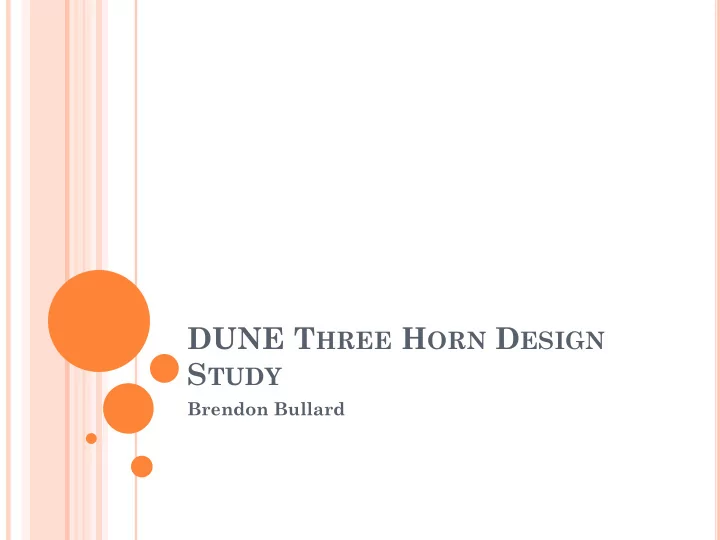

DUNE T HREE H ORN D ESIGN S TUDY Brendon Bullard
P URPOSE Benchmarking G4LBNE/V2 and V3 Want to study focusing performance for a three horn system based off the optimized design Investigate the tunability of this design through the repositioning of Horn 2
P ROCEDURE 50m POT in V2/V3 for reference design and optimized design at 66 and 120 GeV 50m POT in V2 for three horn design at 0.5, 2.0, 4.0, and 6.0 m separation between Horn 1 and Horn 2 Visualization in HepRep (use 50 POT)
R EFERENCE D ESIGN H ORNS
R EFERENCE AND O PTIMIZED D ESIGNS
R EFERENCE D ESIGN : Π + (1-10 G E V) V2 66 GeV V3 V2 120 GeV V3
O PTIMIZED D ESIGN : Π + (1-10 G E V) V2 66 GeV V3 V2 120 GeV V3
R EFERENCE D ESIGN
R EFERENCE D ESIGN
O PTIMIZED D ESIGN
O PTIMIZED D ESIGN
O BSERVATIONS Verify that optimized design outperforms reference V3 has overall lower flux due to the more accurate use of beamline components V3 low energy bins are higher because V2 has automatic low energy cuts
T HREE H ORN D ESIGN Same beam specifications as optimized design, except Horn 1 is cut between L 3 and L 4
V ISUALIZATION OF T HREE H ORN D ESIGN 0.5m 2.0m 4.0m 6.0m
0.5 METER S EPARATION
T HREE H ORN ( ALL SEPARATION LENGTHS ) 66 GeV
C ONCLUSIONS The 0.5 m separation design yields comparable neutrino flux to the optimized design - a three horn design can be found that has equal or better flux Simply moving the location of Horn 2 doesn’t give quality tuning. Likely will be the case for other Horn 2 OC radii
F UTURE W ORK Study anti muon neutrino beam Implement three horn design in G4LBNE/V3 Use a genetic algorithm to optimize the three horn geometry – Horn 2 OC radius and separation distance increase complexity by 2 degrees of freedom
E ND
Recommend
More recommend